DECOUPLING DJANGO WITH DJANGO REST (and a sprinkle of React)

Pycon X - Florence
5 May 2019

Such kid! Much wow!

The plan
- introduction to decoupling
- a (re)introduction to Django REST
- setting up a JavaScript front-end
- focus on testing
- conclusion and resources
Goal of this talk
Give you an overview/ guideline for structuring a Django project with React (or any JavaScript framework/library).
Outline challenges and tradeoffs of a decoupled approach.
By the end of the talk you should be able to configure a new Django REST project with a front-end library for interacting with the API.
1. Introduction
A bit of backstory
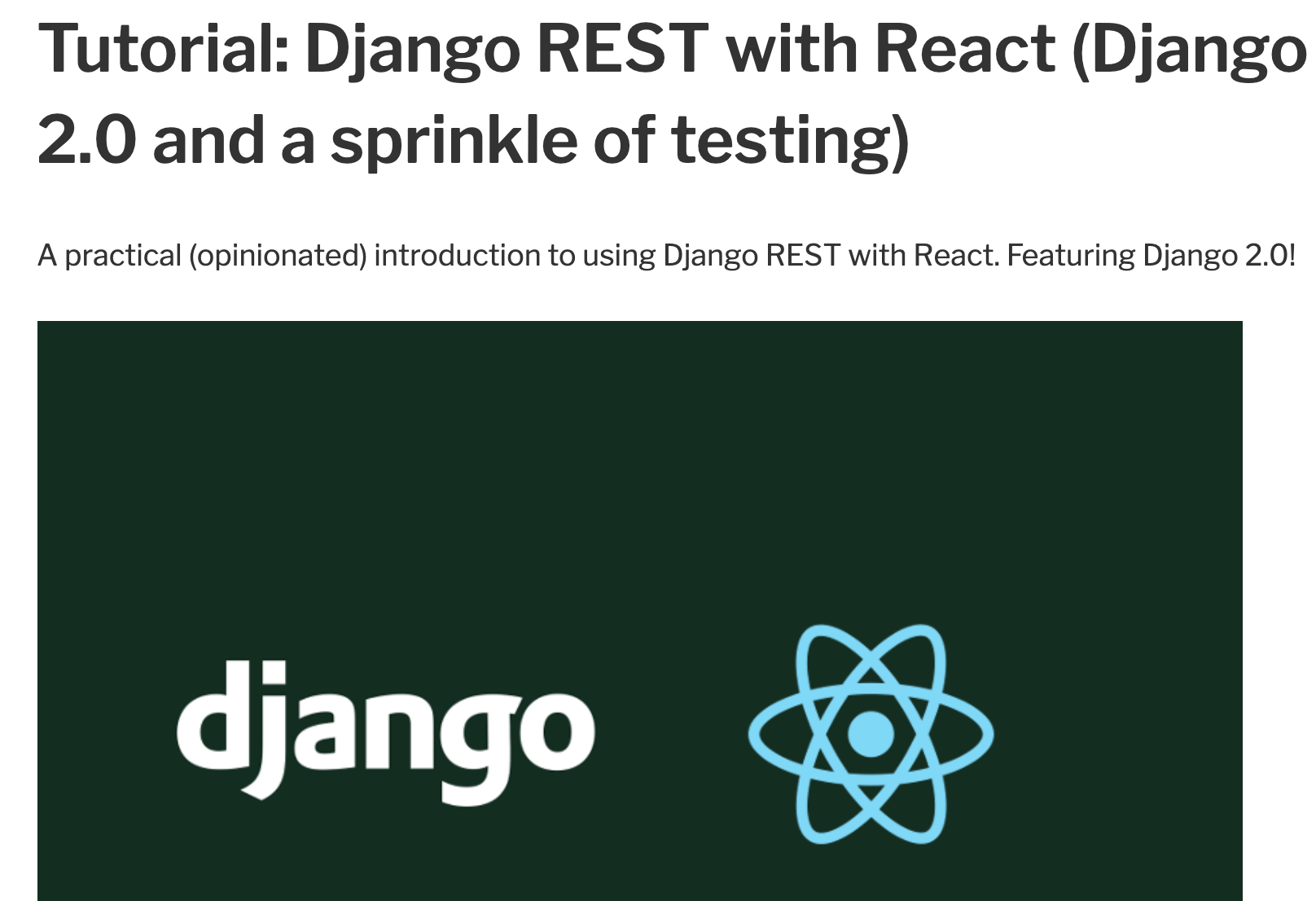
What is "decoupling"?
Exposing data and contents "outside" Django templates, with the help of a REST API.
Decoupling Django means exposing your models as JSON.
JSON

Why decoupling?
Because of flexibility... Back-end and front-end developers can work in isolation. Also, no need to fight build tools.
But a decoupled approach can give a lot of headaches! Code duplication, more testing, more developers.
Challenges
A decoupled approach imposes challenges!
- search engine optimization (SSR or die)
- authentication
- logic duplication (errors and form validation)
- more testing
- more developers
When to decouple?
These are good signs that you will benefit from decoupling:
- lot of JS-driven interactions
- you're building a mobile app
- you're building a dashboard for internal use
When NOT to decouple
These are good signs that you don't need to decouple:
- the application has little or no JS-driven interactions
- you're concerned about SEO
- you want to decouple just because everyone is doing the same ("Medium" driven development)
2. Django REST framework
Django REST framework
Django REST framework is a Django application for building REST APIs on top of Django.
pip install djangorestframework
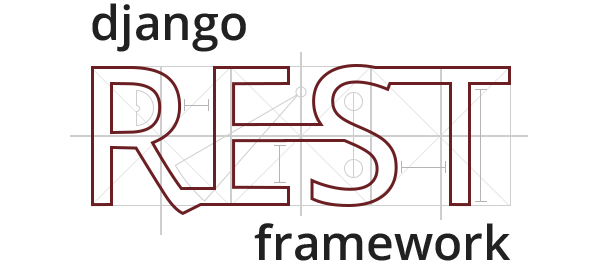
Django models
But first ... Django models!
from django.db import models
"""
some other model here!
"""
class Link(models.Model):
title = models.TextField(max_length=200, unique=True)
url = models.URLField(max_length=250, unique=True)
tags = models.ManyToManyField(Tag)
created_at = models.DateField(auto_now_add=True)DRF serializers
Serializers are a layer between Django models and the outside world (they mirror Django forms).
from rest_framework import serializers
from .models import Linkclass LinkSerializer(serializers.ModelSerializer):
class Meta:
model = Link
fields = ('title', 'url', 'tags') tags = serializers.StringRelatedField(many=True) fields = '__all__' # Don't do thatDRF function views
Views in DRF can be written as plain functions.
from rest_framework.decorators import api_view
from rest_framework.response import Response
from .models import Link
from .serializers import LinkSerializer
@api_view(['GET'])
def link_list(request):
links = Link.objects.all()
serializer = LinkSerializer(links, many=True)
return Response(serializer.data)DRF generic views
But even better with Generic Views.
from rest_framework.generics import ListAPIView
from .models import Link
from .serializers import LinkSerializer
class LinkList(ListAPIView):
serializer_class = LinkSerializer
queryset = Link.objects.all()
Wiring up the urls
After creating a serializer and a view we can expose the API endpoint.
# links/urls.py
from django.urls import path
from .views import LinkList
PREFIX = 'api'
urlpatterns = [
path(f'{PREFIX}/link/', LinkList.as_view()),
]
The result

3. Setting up the frontend
What is React?
React is a front-end library for building composable, reusable, user interfaces.
npm i react react-dom
React components
import React from "react";
function Form(props) {
return <form onSubmit={props.onSubmit}>
{props.children}
</form>;
};
<Form onSubmit={handleSubmit}>
<Input/>
<Button/>
</Form>React components are ... JavaScript functions!
Let's glue things together
And now comes the hard part. Many ways for pairing up a JavaScript frontend to a Django REST API.
A closer look at two practical approaches ...
#1 create-react-app
Approach #1: A CRA React app in app_name/
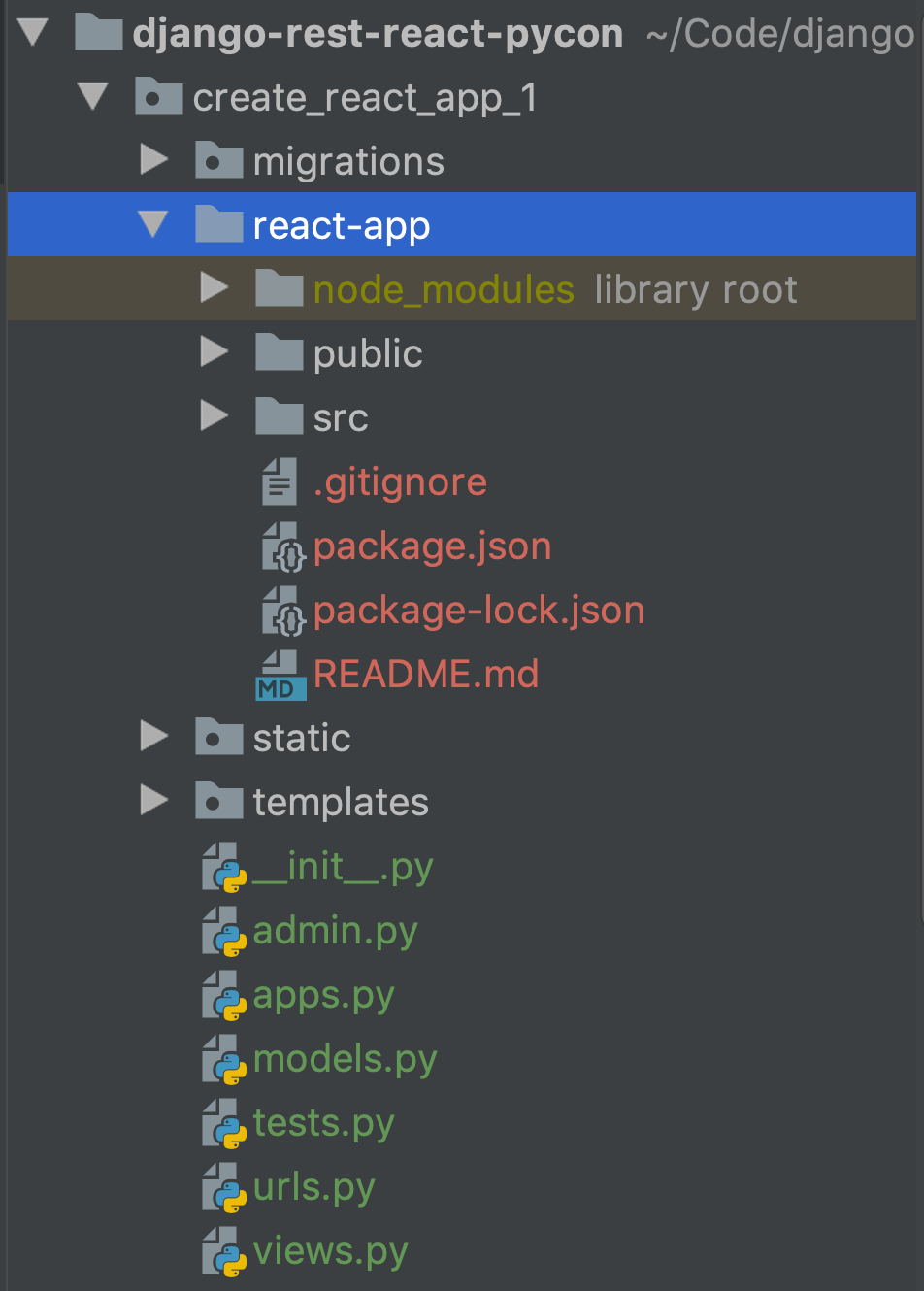
#1 create-react-app
<!-- How about these? -->
<script src="/static/js/2.3310f33a.chunk.js"></script>
<script src="/static/js/main.c82d5dba.chunk.js"></script>
<!-- We do need these instead -->
{% load static %}
<script src="{% static "links/js/2.3310f33a.chunk.js" %}"></script>
<script src="{% static "links/js/main.c82d5dba.chunk.js" %}"></script>
But when running npm run build you get these files:
#2 Custom webpack project
Approach #2: a custom webpack project in app_name/
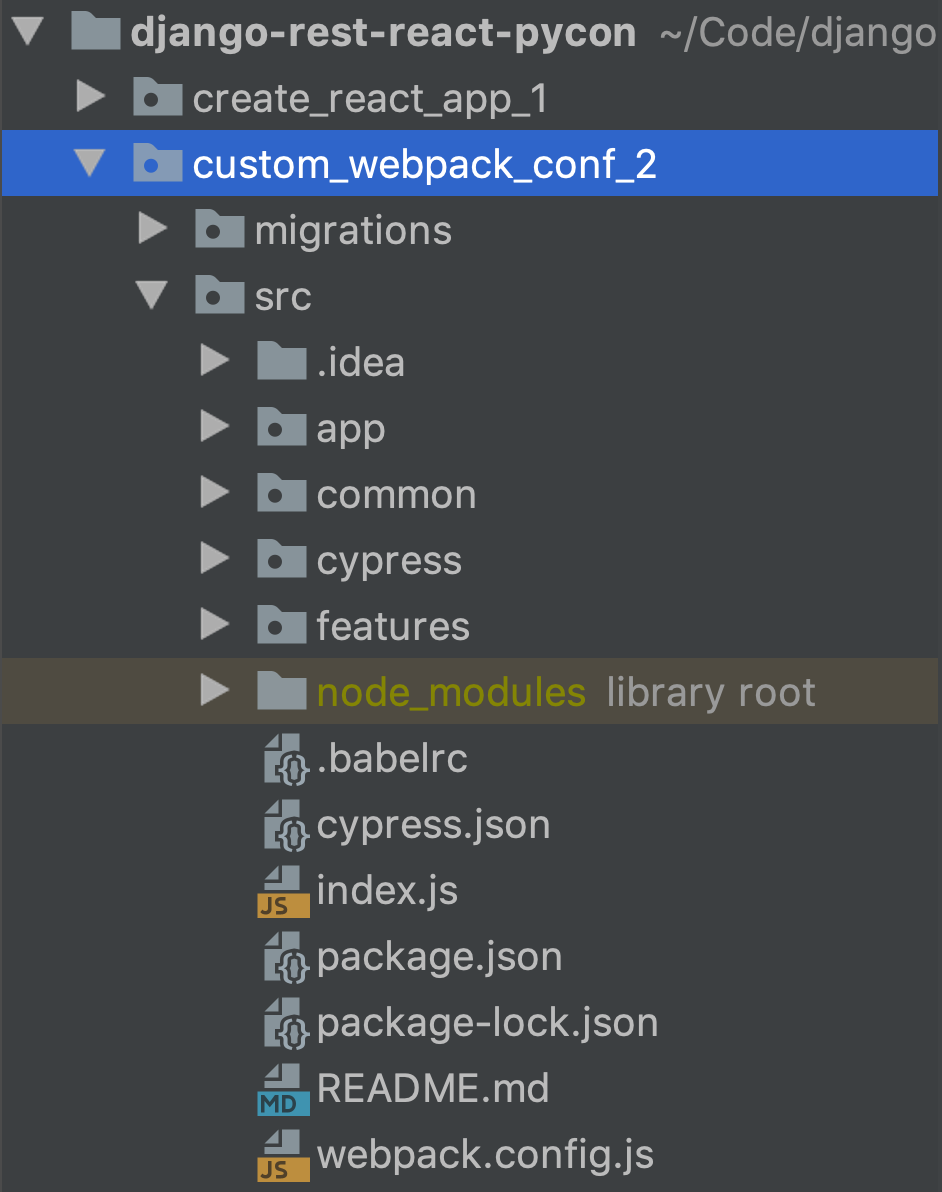
#2 Custom webpack project
We have control over the bundle path! Ok for development:
// webpack.config.js
const path = require("path");
module.exports = {
entry: "./index.js",
output: {
filename: "main.js",
path: path.resolve(__dirname,
"../static/custom_webpack_conf_2/js")
},
module: {
// other stuff
}
};#2 Custom webpack project
<!-- Seems good! -->
{% load static %}
<script src="{% static "links/js/main.js" %}"></script>
But now ... how about splitChunks and code splitting?
"""
Don't forget to expose a view!
"""
def index(request):
return render(request, 'custom_webpack_conf_2/index.html')
#2 Custom webpack project

With splitChunks you can aggressively split your bundle. Ending up with a lot of files ...
How do we inject these files into our Django template?
#2.1 django-webpack-loader
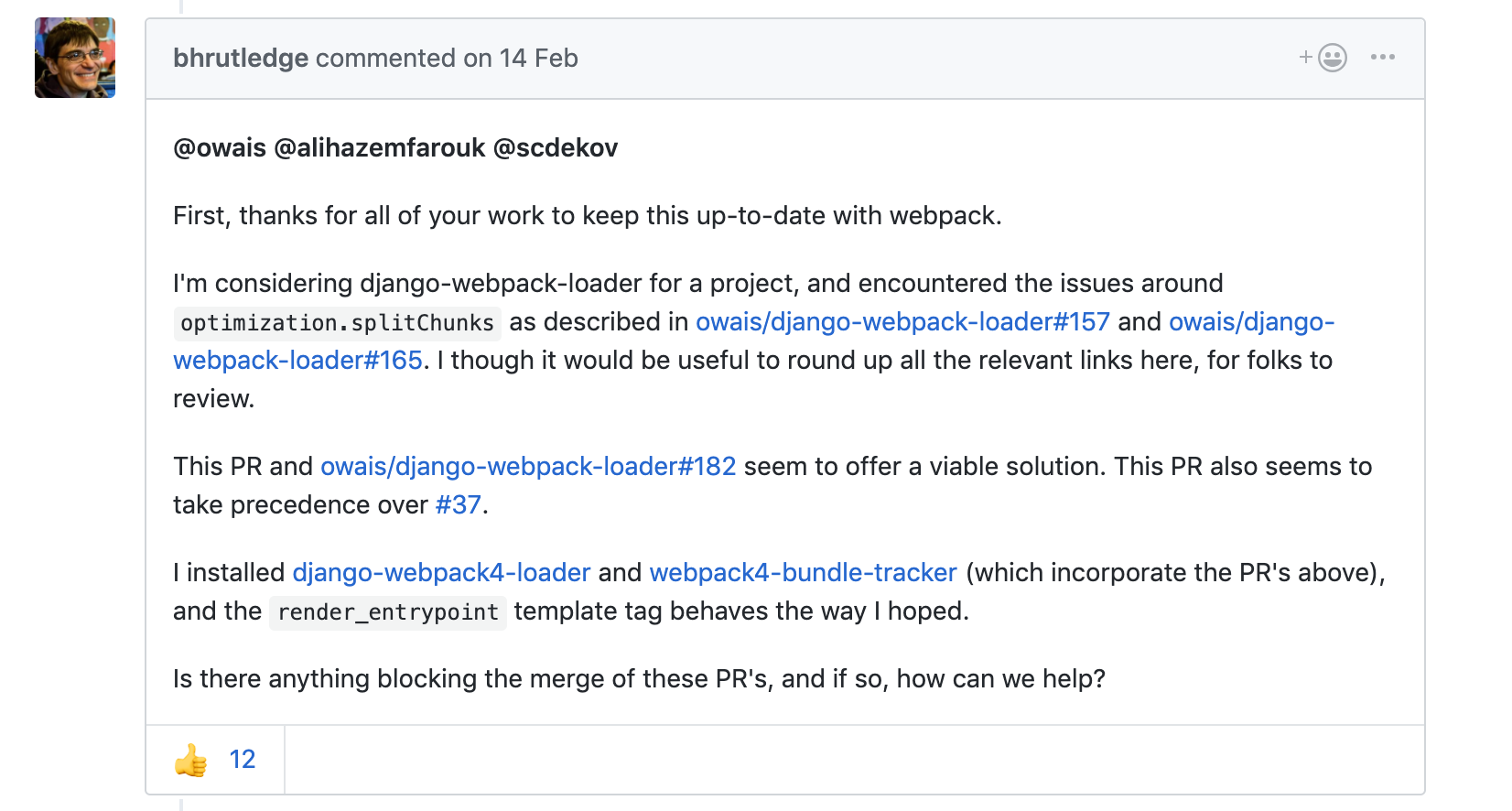
😭
Learning from others
Maybe we can build a "django-webpacker"?

The winner is ...
Fully decoupled front-end! Best of both worlds, you don't fight tools.
Don't forget to enable django-cors-headers! https://github.com/ottoyiu/django-cors-headers/
Do you even authenticate?
Authentication plays an important role in a decoupled setup.
- good ol' Django session authentication
- token based authentication (JWT)
pip install djangorestframework_simplejwt
4. Testing
Testing the front-end
A lot of options for testing the front-end:
- Selenium, (cannot stub the API, semi-auto waiting)
- Cypress, (can stub the API, automatic waiting)
- Splinter, (Selenium abstraction)
UI testing with Cypress
it("Test description (user story)", () => {
cy.server();
cy.visit('/');
cy.route({
method: "POST", url: "**/api/user/token/", status: 401,
response: { access: undefined, refresh: undefined }
});
const emailInput = 'input[name="username"]';
const passwordInput = 'input[name="password"]';
cy.get(emailInput).type("xsasasa");
cy.get(passwordInput).type("changeme");
cy.get("[data-testid=submit]").click();
cy.get("[data-testid=error-message]")
.contains("Unauthorized");
});Testing the API
A lot of options for testing the API too:
- APISimpleTestCase: (no db queries)
- APITestCase: (db is available)
- APILiveServerTestCase
API testing in DRF
from rest_framework.test import APITestCase
from django.contrib.auth.models import User
from ..models import Link, Tag
class SimpleTest(APITestCase):
def setUp(self):
self.path = '/api/link2/'
self.link = Link.objects.create(
title="Some title",
url="someurl"
)
self.tags = [Tag.objects.create(name=tag)
for tag in ['django', 'python']]
[self.link.tags.add(tag) for tag in self.tags]
def test_guest_cannot_see_links(self):
response = self.client.get(self.path)
self.assertEqual(response.status_code, 401)API testing in DRF
# more stuff here
def test_authenticated_user(self):
user = User.objects.create_user(username='valentino',
password='changeme')
self.client.force_authenticate(user=user)
response = self.client.get(self.path)
self.assertEqual(response.status_code, 200)
self.assertEqual(response.data, [{"id": 1,
"title": "Some title",
"url": "someurl",
"tags": ["django", "python"]}])Demo time!
5. Conclusions and resources
Conclusions
Django REST framework is great!
- configuration over coding
- built-in pagination
- authentication and permissions
- throttling
Where to go from here
You may want to investigate more advanced topics:
- DRF router
- DRF viewset
Resources
Get in touch!

Thank you!
